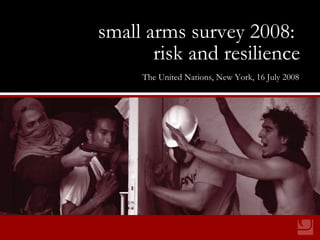Small Arms Survey 2008: Risk and Risilience
- 1. small arms survey 2008: risk and resilience small arms survey 2008: risk and resilience The United Nations, New York, 16 July 2008
- 2. small arms survey 2008: risk and resilience Small Arms Survey: aims and work small arms survey 2008: risk and resilience An independent research institute based in Geneva with a mandate to investigate all aspects of small arms and armed violence issues Provide reliable and impartial policy-relevant analysis Work closely with a global network of partners Two Themes: Diversion from state and civilian stockpiles The public health approach to armed violence
- 3. The public health approachŌĆ” Widely used to study and control diseases and epidemics Also used to study and control accidents and other health hazards such as smoking Increasingly used to study violence Focuses on prevention small arms survey 2008: risk and resilience
- 4. small arms survey 2008: risk and resilience A four-step process small arms survey 2008: risk and resilience Identify problem and collect data Identify risk and resilience factors Design violence prevention programmes Assess programmes and implement effective ones
- 5. small arms survey 2008: risk and resilience Definitions small arms survey 2008: risk and resilience Risk: any factor that contributes to the increased likelihood of a person engaging in a violent act or becoming a victim of violence Resilience: any factor that enables an individual to manage adversity and respond to risk in a positive fashion
- 6. small arms survey 2008: risk and resilience The ecological model small arms survey 2008: risk and resilience High levels of inequality Cultural norms enabling violence Weak rule of law COMMUNITY Presence of gangs Lack of economic opportunities Weak ties between community members RELATIONSHIP Violence in the home Poor parental supervision Delinquent peers SOCIETAL Early aggressive behaviour Low academic achievement Poor social skills Substance abuse INDIVIDUAL
- 7. small arms survey 2008: risk and resilience Risk factors over time small arms survey 2008: risk and resilience Childhood Adolescence Early adulthood Family Parenting Substance abuse Social skills Substance abuse Social skills Biology Peers Gangs School Work Social norms Having a family Relationships Parenting
- 8. small arms survey 2008: risk and resilience Known risk factors for violence small arms survey 2008: risk and resilience Individual Family Peer Community Society Birth defects Personality disorders Early aggressive behaviour Low academic achievement Weak family bonds Violence in the home Poor parental supervision Poor social skills Anti-social behaviour Involvement with delinquent peers Presence of gangs, drugs, arms Poor social organization Low employment Poor economy High levels of inequality Social norms supportive of violence
- 9. small arms survey 2008: risk and resilience Youth violence small arms survey 2008: risk and resilience Individual Family Peer School Attention deficit History of early aggression Low cognitive skills Substance abuse Exposure to violence in the home Poor parental supervision Poor parenting Parental substance abuse Poor social skills Peer substance abuse Involvement in gangs Associating with delinquent peers Social rejection by peers Lack of involvement in extracurricular activities Poor academic performance Low commitment to school Poor environment Bullying
- 10. small arms survey 2008: risk and resilience Targeting types of violence? small arms survey 2008: risk and resilience Domestic violence Gang violence Youth violence Gun violence










